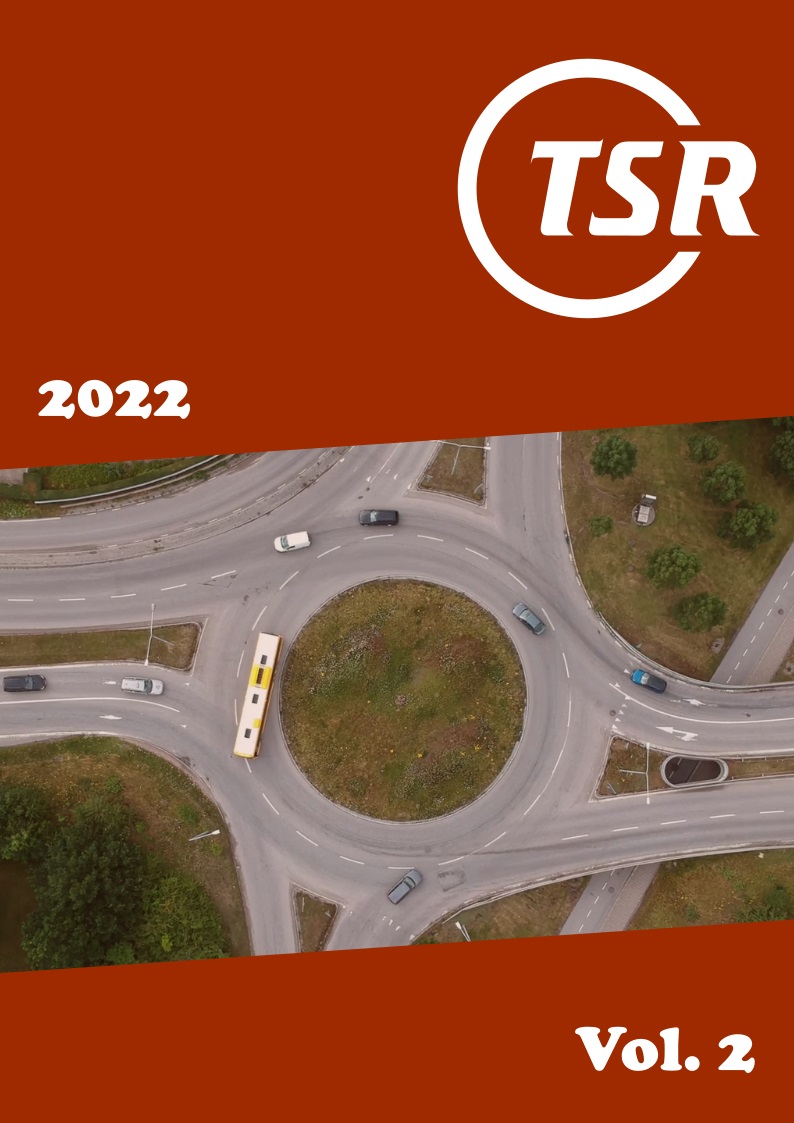GIS techniques to analyze factors associated with crash occurrence
DOI:
https://doi.org/10.55329/wmfk3422Keywords:
crash occurence, relative accident involvement ratio (RAIR), choropleth mapAbstract
Fatality rates in Kentucky have been higher than the national average for the past decade. Prior research postulated that the region’s unique socioeconomic conditions could provide a compelling explanation of the higher cash rates of the southeast in the US. This study examines the relationship between safety and socioeconomic characteristics using an extensive spatial analysis of crashes in Kentucky. Quasi-induced exposure technique was utilized to determine the crash propensity of different driver groups. Through a series of GIS techniques and spatial analysis, the relative accident involvement ratios were calculated for each group of drivers. The findings of the study concur with the previous findings between driving behavior and demographic factors such as age and gender. The study also attempted to explain the regional disparities in crash occurrence across the state in terms of economic status. The study concluded that the drivers residing in the Appalachian regions have a higher propensity to cause a crash, regardless of the age and gender of the driver. The findings of the study can be used to identify high risk counties for the Safety Circuit Rider (SCR) program in Kentucky.
Downloads
References
Adanu, E. K., R. Smith, L. Powell, S. Jones (2017) Multilevel analysis of the role of human factors in regional disparities in crash outcomes. Accident Analysis & Prevention 109, 10-17: https://doi.org/10.1016/j.aap.2017.09.022
Aguero-Valverde, J., P. P. Jovanis (2006) Spatial analysis of fatal and injury crashes in Pennsylvania. Accident Analysis & Prevention 38 (3), 618-625: https://doi.org/10.1016/j.aap.2005.12.006
Blatt, J., S. M. Furman (1998) Residence location of drivers involved in fatal crashes. Accident Analysis & Prevention 30 (6), 705-711: https://doi.org/10.1016/s0001-4575(98)00014-1
Brown, K. T. (2016) A safety analysis of spatial phenomena about the residences of drivers involved in crashes. PhD thesis. Clemson University. Graduate School. 1746: https://tigerprints.clemson.edu/all_dissertations/1746
Budzyński, M., W. Kustra, R. Okraszewska, K. Jamroz, J. Pyrchla (2018) The use of GIS tools for road infrastructure safety management. E3S Web of Conferences 26, 00009: https://doi.org/10.1051/e3sconf/20182600009
Carr, B. R. (1969) A statistical analysis of rural Ontario traffic accidents using induced exposure data. Accident Analysis & Prevention 1 (4), 343-357: https://doi.org/10.1016/0001-4575(69)90080-3
Chandraratna, S., N. Stamatiadis (2009) Quasi-induced exposure method: Evaluation of not-at-fault assumption. Accident Analysis & Prevention 41 (2), 308-313: https://doi.org/10.1016/j.aap.2008.12.005
Chandraratna, S., N. Stamatiadis, A. Stromberg (2005) Potential Crash Involvement of Young Novice Drivers with Previous Crash and Citation Records. Transportation Research Record 1937 (1), 1-6: https://doi.org/10.1177/0361198105193700101
Chen, H. Y., R. Q. Ivers, A. L. C. Martiniuk, S. Boufous, T. Senserrick, M. Woodward, M. Stevenson, R. Norton (2010) Socioeconomic status and risk of car crash injury, independent of place of residence and driving exposure: results from the DRIVE Study. Journal of Epidemiology & Community Health 64 (11), 998-1003: https://doi.org/10.1136/jech.2009.091496
Chen, L.-H., S. P. Baker, E. R. Braver, G. Li (2000) Carrying Passengers as a Risk Factor for Crashes Fatal to 16- and 17-Year-Old Drivers. JAMA 283 (12), 1578: https://doi.org/10.1001/jama.283.12.1578
Cooper, P. J., M. Pinili, W. Chen (1995) An examination of the crash involvement rates of novice drivers aged 16 to 55. Accident Analysis & Prevention 27 (1), 89-104: https://doi.org/10.1016/0001-4575(94)00052-n
Curry, A. E., M. R. Pfeiffer, M. R. Elliott (2016) Validation of quasi-induced exposure representativeness assumption among young drivers. Traffic Injury Prevention 17 (4), 346-351: https://doi.org/10.1080/15389588.2015.1091072
Factor, R., D. Mahalel, G. Yair (2008) Inter-group differences in road-traffic crash involvement. Accident Analysis & Prevention 40 (6), 2000-2007: https://doi.org/10.1016/j.aap.2008.08.022
FAHE (2019) Appalachian Poverty: https://fahe.org/appalachian-poverty (Acc. 4 Feb 2022)
Gross, F., D. Nabors, R. Eck, M. Hood (2009) Safety Ciruit Rider Programs Best Practices Guide. Federal Highway Administration Office of Safety, U.S. Department of Transportation. FHWA-SA-09-019: https://safety.fhwa.dot.gov/local_rural/training/fhwasa09019/fhwasa09019.pdf
Hanna, C. L., L. Laflamme, C. R. Bingham (2012) Fatal crash involvement of unlicensed young drivers: County level differences according to material deprivation and urbanicity in the United States. Accident Analysis & Prevention 45, 291-295: https://doi.org/10.1016/j.aap.2011.07.014
Harrah, J. (2015) Kentucky Metropolitan Areas Out-Perform Rural and Small Urban Areas. The Community Research Collaborative Blog: http://crcblog.typepad.com/crcblog/kentucky-metropolitan-areas-out-perform-rural-and-small-urban-areas.html (Acc. 4 Feb 2022)
Hasselberg, M., M. Vaez, L. Lucie (2005) Socioeconomic aspects of the circumstances and consequences of car crashes among young adults. Social Science & Medicine 60 (2), 287-295: https://doi.org/10.1016/j.socscimed.2004.05.006
Ivan, J., A. Burnicki, K. Wang, S. Mamun (2016) Improvemnts to road safety improvement selection procedures for Connecticut. Joint Highway Research Advisory Council (JHRAC) of the University of Connecticut. JHR 16-328
Kearney, P. A., L. Stallones, C. Swartz, D. E. Barker, S. B. Johnson (1990) Unintentional Injury Death Rates in Rural Appalachia. The Journal of Trauma: Injury, Infection, and Critical Care 30 (12), 1524-1532: https://doi.org/10.1097/00005373-199012000-00016
KGS (n.d.) Kentucky Geological Survey. University of Kentucky: http://www.uky.edu/KGS/gis/bounds.html (Acc. 4 Feb 2022)
KSP (n.d.) Kentucky Collision Analysis. Kentucky State Police: http://crashinformationky.org (Acc. 4 Feb 2022)
KTC (2003) Traffic Collision Facts 2002. Kentucky Transportation Center, University of Kentucky: https://doi.org/10.13023/ktc.rr.2002.n01
KTC (2018) Traffic Collision Facts 2017. Kentucky Transportation Center, University of Kentucky: https://doi.org/10.13023/ktc.rr.2018.n01
KTC (n.d.) Safety Circuit Rider Program. Kentucky Transportation Center, University of Kentucky: http://www.kyt2.com/local-services/safety-circuit-rider-program (Acc. 4 Feb 2022)
Lee, J., M. Abdel-Aty, K. Choi (2014) Analysis of residence characteristics of at-fault drivers in traffic crashes. Safety Science 68, 6-13: https://doi.org/10.1016/j.ssci.2014.02.019
Lyles, R. W., P. Stamatiadis, D. R. Lighthizer (1991) Quasi-induced exposure revisited. Accident Analysis & Prevention 23 (4), 275-285: https://doi.org/10.1016/0001-4575(91)90005-p
Méndez, Á. G., F. A. Izquierdo (2010) Quasi-induced exposure: The choice of exposure metrics. Accident Analysis & Prevention 42 (2), 582-588: https://doi.org/10.1016/j.aap.2009.10.003
Murray, Å. (1998) The home and school background of young drivers involved in traffic accidents. Accident Analysis & Prevention 30 (2), 169-182: https://doi.org/10.1016/s0001-4575(97)00088-2
NHTSA (2018) Critical Reasons for Crashes Investigated in the National Motor Vehicle Crash Causation Survey. National Highway Traffic Safety Administration, U.S. Department of Transportation: https://crashstats.nhtsa.dot.gov/Api/Public/ViewPublication/812506
Noland, R. B., L. Oh (2004) The effect of infrastructure and demographic change on traffic-related fatalities and crashes: a case study of Illinois county-level data. Accident Analysis & Prevention 36 (4), 525-532: https://doi.org/10.1016/s0001-4575(03)00058-7
Noland, R. B., M. A. Quddus (2004) A spatially disaggregate analysis of road casualties in England. Accident Analysis & Prevention 36 (6), 973-984: https://doi.org/10.1016/j.aap.2003.11.001
Sagar, S. (2020) Effect of Socioeconomic and Demographic Factors of Driver Residence on Crash Occurence. University of Kentucky. Civil Engineering: https://doi.org/10.13023/etd.2020.152
Sagar, S., N. Stamatiadis, A. Stromberg (2021) Effect of Socioeconomic and Demographic Factors on Crash Occurrence. Transportation Research Record 2675 (12), 80-91: https://doi.org/10.1177/03611981211027887
Sagar, S., N. Stamatiadis, S. Wright, A. Cambron (2020) Identifying high-risk commercial vehicle drivers using sociodemographic characteristics. Accident Analysis & Prevention 143, 105582: https://doi.org/10.1016/j.aap.2020.105582
Shahzad, M. (2020) Review of road accident analysis using GIS technique. International Journal of Injury Control and Safety Promotion 27 (4), 472-481: https://doi.org/10.1080/17457300.2020.1811732
Stamatiadis, N., J. A. Deacon (1997) Quasi-induced exposure: Methodology and insight. Accident Analysis & Prevention 29 (1), 37-52: https://doi.org/10.1016/s0001-4575(96)00060-7
Stamatiadis, N., G. Puccini (1999) Fatal Crash Rates in the Southeastern United States: Why Are They Higher? Transportation Research Record 1665 (1), 118-124: https://doi.org/10.3141/1665-16
Staplin, L., K. H. Lococo, J. Stewart, L. E. Decina (1999) Safety mobility for older drivers handbook. National Highway Traffic Safety Administration
US Census Bureau (2021) American Community Survey. United States Census Bureau: https://www.census.gov/programs-surveys/acs (Acc. 4 Feb 2022)
US Census Bureau (n.d.) Mapping Files. United States Census Bureau: https://www.census.gov/geographies/mapping-files.html (Acc. 4 Feb 2022)
Westerling, R., A. Gullberg, M. Rosén (1996) Socioeconomic Differences in ‘Avoidable’ Mortality in Sweden 1986–1990. International Journal of Epidemiology 25 (3), 560-567: https://doi.org/10.1093/ije/25.3.560
Whitlock, G., R. Norton, T. Clark, M. Pledger, R. Jackson, S. MacMahon (2003) Motor vehicle driver injury and socioeconomic status: a cohort study with prospective and retrospective driver injuries. Journal of epidemiology and community health 57 (7), 512-516: https://doi.org/10.1136/jech.57.7.512
Zhang, G., X. Jiang, X. Qiu, Y. Fan, C. Huang, M. Wei (2021) Validating the underlying assumption of quasi-induced exposure technique disaggregated by crash injury severity. Journal of Safety Research 76, 197-204: https://doi.org/10.1016/j.jsr.2020.12.007
Zhu, M., S. Zhao, K. K. Gurka, S. Kandati, J. H. Coben (2013) Appalachian versus non-Appalachian U.S. traffic fatalities, 2008-2010. Annals of Epidemiology 23 (6), 377-380: https://doi.org/10.1016/j.annepidem.2013.04.001
Downloads
Published
How to Cite
Issue
Section
License
Copyright (c) 2022 Shraddha Sagar, Nikiforos Stamatiadis

This work is licensed under a Creative Commons Attribution 4.0 International License.







